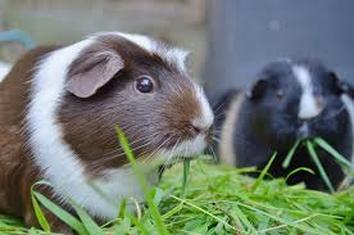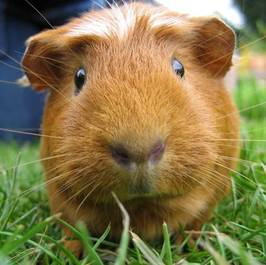Guinea Pigs
Guinea pigs are fantastic, social rodents that can make excellent, long-lived pets with proper care. However, there are important things you need to know to keep your guinea pig in good health and prevent them from being susceptible to certain common conditions.
1. Diet

Many of the common guinea pig concerns seen at the veterinarian's office are related to inappropriate diets.
- Think of your guinea pig like a very tiny horse--they have continuously growing teeth and should eat hay and other greens as their primary diet. Grass hays include timothy, orchard and oat. Hay provides the necessary side-to-side chewing action to keep teeth properly worn, and prevents dental problems related to overgrown molars. Hay also provides a variety of nutrients, indigestible fiber to keep the intestinal tract moving normally, and digestible fiber that is used by intestinal bacteria to produce Vitamin B and amino acids. Alfalfa hay should be avoided for most guinea pigs (unless underweight), as it contains too much calcium and protein and is high in calories Alfalfa is actually a legume and not a grass. You can find appropriate hay for your guinea pig at: Oxbow Animal Health
- Your guinea pig can have a small amount of pellets, but the pellet mixes advertised as "gourmet" that contain seeds and dried fruits are not an appropriate diet. You can find appropriate pellets at: Oxbow Animal Health
- One ESSENTIAL part of a guinea pig's diet is Vitamin C. This is best delivered through fresh greens, vegetables, and fruits. A healthy guinea pig requires 25 mg/day of Vitamin C. Please see the list below to figure out which foods will be best for getting proper nutrients into your pig.
2. Cage & Bedding

- Minimum size requirements are 100 square inches per each neutered guinea pig and 180 square inches per breeding guinea pig.
- Enclosures can be made of different materials but wood should be avoided, as it is impossible to thoroughly clean.
- Although wire floors make for easy cleaning, they are hard on guinea pig feet! At least half of the cage should be solid flooring. Guinea pigs can end up with broken legs if their feet fall through wire grating, so entirely solid flooring is recommended.
- Thick bedding is essential to keep feet dry and protected. Sores can result on the feet from inadequate bedding, and are an EXTREMELY difficult condition to manage or resolve.
- Appropriate bedding consists of recycled paper pulp, shredded newspaper, commercial pellets, and wood shavings. AVOID: Cedar shavings (can cause respiratory problems or liver disease), Sawdust (can become lodged in the external genital area of male guinea pigs), and corn cob pellets (can contain fungal spores if not properly processed).
